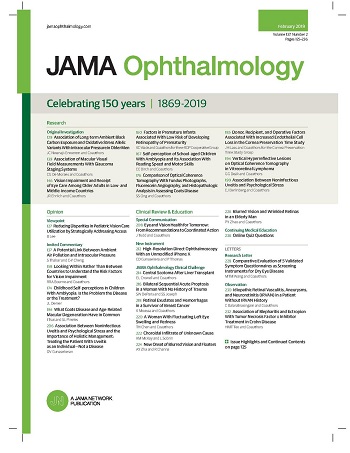Femtosecond Laser Arcuate Keratotomy vs Toric Intraocular Lens Implantation in Cataract Surgery
IF 7.8
1区 医学
Q1 OPHTHALMOLOGY
引用次数: 0
Abstract
ImportanceAfter cataract surgery, postoperative residual astigmatism can influence a patient’s visual quality and satisfaction. Finding ways to minimize this astigmatism is important.ObjectiveTo compare the clinical outcomes of femtosecond laser arcuate keratotomy (FSAK) and toric intraocular lens (TIOL) implantation for astigmatism correction in patients undergoing femtosecond laser-assisted cataract surgery.Design, Setting, and ParticipantsThis randomized clinical trial was conducted between October 2021 and September 2023 at the Eye Center of the Second Affiliated Hospital, School of Medicine, Zhejiang University, China. Patients with mild to moderate regular corneal astigmatism ranging from 0.75 diopters (D) to 3.00 D were recruited.InterventionsPatients were randomly assigned in a 1:1 ratio to receive FSAK or TIOL implantation.Main Outcomes and MeasuresThe primary outcome was the subjective manifest refraction assessed at 3 months postoperatively.ResultsA total of 196 patients (mean [SD] age, 68.4 [13.7] years; 124 female [63%]) were randomized to the FSAK group (98 [50%]) or TIOL group (98 [50%]), and 92 patients (94%) and 95 patients (97%), respectively, finished the 3-month follow-up. At 3 months postoperatively, there was no difference in the refractive astigmatism between the 2 groups (mean [SD], 0.64 [0.64] D vs 0.54 [0.55] D; difference, 0.11 D; 95% CI, −0.06 to 0.27 D;飞秒激光弓形角膜切开术与环形人工晶体植入术在白内障手术中的应用
重要性白内障手术后,术后残余散光会影响患者的视觉质量和满意度。找到减少这种散光的方法很重要。目的比较飞秒激光弓形角膜切开术(FSAK)与环形人工晶状体(TIOL)植入术治疗飞秒激光辅助白内障术后散光的临床效果。设计、环境和参与者本随机临床试验于2021年10月至2023年9月在中国浙江大学医学院第二附属医院眼科中心进行。轻度至中度常规角膜散光患者,范围从0.75屈光度(D)到3.00 D。患者按1:1的比例随机分配接受FSAK或TIOL植入。主要结果和措施主要结果是术后3个月主观明显屈光评估。结果共196例患者,平均[SD]年龄68.4[13.7]岁;124例女性(63%)随机分为FSAK组(98例[50%])和TIOL组(98例[50%]),分别有92例(94%)和95例(97%)患者完成了3个月的随访。术后3个月,两组屈光散光无差异(平均[SD]: 0.64 [0.64] D vs 0.54 [0.55] D;差值0.11 D;95% CI,−0.06 ~ 0.27 D;P = .21)。FSAK组未经校正的平均(SD)距离视力为0.15 (0.20)logMAR (Snellen当量,20/28),TIOL组为0.14 (0.19)logMAR (Snellen当量,20/28)(差异0.01 D;95% CI,−0.04 ~ 0.06 D;P = .71)。亚组分析显示,在治疗超过1.5 D的散光或反规则散光时,TIOL植入比FSAK获得更低的残余散光。本随机临床试验的结果表明,在接受飞秒激光辅助白内障手术的轻度至中度散光患者中,FSAK矫正散光的效果并不优于TIOL植入术。然而,对于散光超过1.5 D或反规则散光,TIOL植入比FSAK更有效。亚组分析表明,TIOL植入是否比FSAK更有效,需要进一步的试验来确定。试验注册号:ChiCTR2100051066
本文章由计算机程序翻译,如有差异,请以英文原文为准。
求助全文
约1分钟内获得全文
求助全文
来源期刊

JAMA ophthalmology
OPHTHALMOLOGY-
CiteScore
13.20
自引率
3.70%
发文量
340
期刊介绍:
JAMA Ophthalmology, with a rich history of continuous publication since 1869, stands as a distinguished international, peer-reviewed journal dedicated to ophthalmology and visual science. In 2019, the journal proudly commemorated 150 years of uninterrupted service to the field. As a member of the esteemed JAMA Network, a consortium renowned for its peer-reviewed general medical and specialty publications, JAMA Ophthalmology upholds the highest standards of excellence in disseminating cutting-edge research and insights. Join us in celebrating our legacy and advancing the frontiers of ophthalmology and visual science.
 求助内容:
求助内容: 应助结果提醒方式:
应助结果提醒方式:


